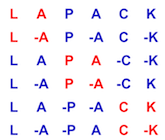129 SUBROUTINE zsytrf_aa( UPLO, N, A, LDA, IPIV, WORK, LWORK, INFO)
139 INTEGER N, LDA, LWORK, INFO
143 COMPLEX*16 A( LDA, * ), WORK( * )
149 parameter( zero = 0.0d+0, one = 1.0d+0 )
152 LOGICAL LQUERY, UPPER
154 INTEGER NB, MJ, NJ, K1, K2, J1, J2, J3, JB
160 EXTERNAL lsame, ilaenv
174 nb = ilaenv( 1,
'ZSYTRF_AA', uplo, n, -1, -1, -1 )
179 upper = lsame( uplo,
'U' )
180 lquery = ( lwork.EQ.-1 )
181 IF( .NOT.upper .AND. .NOT.lsame( uplo,
'L' ) )
THEN
183 ELSE IF( n.LT.0 )
THEN
185 ELSE IF( lda.LT.max( 1, n ) )
THEN
187 ELSE IF( lwork.LT.max( 1, 2*n ) .AND. .NOT.lquery )
THEN
197 CALL xerbla(
'ZSYTRF_AA', -info )
199 ELSE IF( lquery )
THEN
215 IF( lwork.LT.((1+nb)*n) )
THEN
227 CALL zcopy( n, a( 1, 1 ), lda, work( 1 ), 1 )
246 jb = min( n-j1+1, nb )
252 $ a( max(1, j), j+1 ), lda,
253 $ ipiv( j+1 ), work, n, work( n*nb+1 ) )
257 DO j2 = j+2, min(n, j+jb+1)
258 ipiv( j2 ) = ipiv( j2 ) + j
259 IF( (j2.NE.ipiv(j2)) .AND. ((j1-k1).GT.2) )
THEN
260 CALL zswap( j1-k1-2, a( 1, j2 ), 1,
261 $ a( 1, ipiv(j2) ), 1 )
274 IF( j1.GT.1 .OR. jb.GT.1 )
THEN
280 CALL zcopy( n-j, a( j-1, j+1 ), lda,
281 $ work( (j+1-j1+1)+jb*n ), 1 )
282 CALL zscal( n-j, alpha, work( (j+1-j1+1)+jb*n ), 1 )
305 nj = min( nb, n-j2+1 )
311 CALL zgemv(
'No transpose', mj, jb+1,
312 $ -one, work( j3-j1+1+k1*n ), n,
314 $ one, a( j3, j3 ), lda )
320 CALL zgemm(
'Transpose',
'Transpose',
322 $ -one, a( j1-k2, j2 ), lda,
323 $ work( j3-j1+1+k1*n ), n,
324 $ one, a( j2, j3 ), lda )
334 CALL zcopy( n-j, a( j+1, j+1 ), lda, work( 1 ), 1 )
346 CALL zcopy( n, a( 1, 1 ), 1, work( 1 ), 1 )
365 jb = min( n-j1+1, nb )
371 $ a( j+1, max(1, j) ), lda,
372 $ ipiv( j+1 ), work, n, work( n*nb+1 ) )
376 DO j2 = j+2, min(n, j+jb+1)
377 ipiv( j2 ) = ipiv( j2 ) + j
378 IF( (j2.NE.ipiv(j2)) .AND. ((j1-k1).GT.2) )
THEN
379 CALL zswap( j1-k1-2, a( j2, 1 ), lda,
380 $ a( ipiv(j2), 1 ), lda )
393 IF( j1.GT.1 .OR. jb.GT.1 )
THEN
399 CALL zcopy( n-j, a( j+1, j-1 ), 1,
400 $ work( (j+1-j1+1)+jb*n ), 1 )
401 CALL zscal( n-j, alpha, work( (j+1-j1+1)+jb*n ), 1 )
424 nj = min( nb, n-j2+1 )
430 CALL zgemv(
'No transpose', mj, jb+1,
431 $ -one, work( j3-j1+1+k1*n ), n,
432 $ a( j3, j1-k2 ), lda,
433 $ one, a( j3, j3 ), 1 )
439 CALL zgemm(
'No transpose',
'Transpose',
441 $ -one, work( j3-j1+1+k1*n ), n,
442 $ a( j2, j1-k2 ), lda,
443 $ one, a( j3, j2 ), lda )
453 CALL zcopy( n-j, a( j+1, j+1 ), 1, work( 1 ), 1 )

